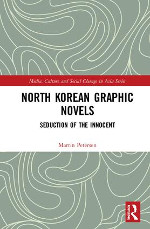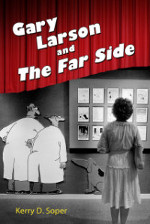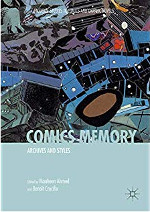Monitor is an irregularly published overview of publications from the previous six months that may be of relevance to comics studies scholars. The introductory texts are the respective publishers’. Do you have suggestions or information on new releases that have been overlooked and should be introduced on our website? Please let us know via email: redaktion@comicgesellschaft.de. → See previous Monitor posts.
Lone Heroes and the Myth of the American West in Comic Books, 1945-1962
David Huxley
Palgrave Macmillan
90 pages
ISBN 978-3-319-93084-8 (Hardcover)
~€ 58,84
July 2018
Publisher’s homepage
This book examines the role of comics in the perpetuation of the myth of the American West. In particular, it looks at the ways in which lone central characters, and their acts of violence, are posited as heroic. In doing so, the book raises questions both about the role of women in a supposedly male space, in addition to the portrayal of Native Americans within the context of this violence. Various adaptations of historical figures, such as Buffalo Bill and Billy the Kid, as well as film and television stars such as The Lone Ranger and Dale Evans are examined in detail. Although concentrating on American comics, examples both from Britain and France are also analyzed.
North Korean Graphic Novels: Seduction of the Innocent?
Martin Petersen
Routledge
306 pages
ISBN 978-1138046931 (Hardcover)
~£ 84.00
July 2018
Publisher’s homepage
Graphic novels (kurimchaek) are a major art form in North Korea, produced by agents of the regime to set out its vision in a range of important areas. This book provides an analysis of North Korean graphic novels, discussing the ideals they promote and the tensions within those ideals, and examining the reception of graphic novels in North Korea and by North Korean refugees in South Korea. Particular themes considered include the ideal family and how the regime promotes this; patriotism, and its conflict with class identities; and the portrayal of the Korean War – “The Fatherland Liberation War”, as it is known in North Korea – and the subsequent, continuing stand-off. Overall, the book demonstrates the importance of graphic novels in North Korea as a tool for bringing up children and for promoting North Korean ideals. In addition, however, the book also shows that although the regime sees the imaginative power of graphic novels as a necessity for effective communication, graphic novels are also viewed with caution in that they exist in everyday social life in ways that the regime may be aware of, and seeks to control, but cannot dominate completely.
Gary Larson and The Far Side
Kerry D. Soper
University Press of Mississippi
224 pages
ISBN 978-1496817631 (Softcover)
~$25.00
August 2018
Publisher’s homepage
Kerry D. Soper reminds us of The Far Side‘s groundbreaking qualities and cultural significance in Gary Larson and “The Far Side.” In the 1980s, Gary Larson (b. 1950) shook up a staid comics page by introducing a set of aesthetic devices, comedic tones, and philosophical frames that challenged and delighted many readers, even while upsetting and confusing others. His irreverent, single panels served as an alternative reality to the tame comedy of the family-friendly newspaper comics page, as well as the pervasive, button-down consumerism and conformity of the Reagan era.
In this first full study of Larson’s art, Soper follows the arc of the cartoonist’s life and career, describing the aesthetic and comedic qualities of his work, probing the business-side of his success, and exploring how The Far Side brand as a whole – with its iconic characters and accompanying set of comedic and philosophical frames – connected with its core readers. In effect, Larson reinvented his medium by creatively working within, pushing against, and often breaking past institutional, aesthetic, comedic, and philosophical parameters.
Comics Memory: Archives and Styles
Maaheen Ahmed and Benoît Crucifix (eds.)
Palgrave Macmillan
290 pages
ISBN 978-3-319-91745-0 (Hardcover)
~€ 106,99
August 2018
Publisher’s homepage
Despite the boom in scholarship in both Comics Studies and Memory Studies, the two fields rarely interact—especially with issues beyond the representation of traumatic and autobiographical memories in comics. With a focus on the roles played by styles and archives—in their physical and metaphorical manifestations—this edited volume offers an original intervention, highlighting several novel ways of thinking about comics and memory as comics memory. Bringing together scholars as well as cultural actors, the contributions combine studies on European and North American comics and offer a representative overview of the main comics genres and forms, including superheroes, Westerns, newspaper comics, diary comics, comics reportage and alternative comics. In considering the many manifestations of memory in comics as well as the functioning and influence of institutions, public and private practices, the book exemplifies new possibilities for understanding the complex entanglements of memory and comics.
Comic Books, Graphic Novels and the Holocaust: Beyond Maus
Ewa Stańczyk (ed.)
Routledge
132 pages
ISBN 978-1138598645 (Hardcover)
~£ 92,00
September 2018
Publisher’s homepage
This book analyses the portrayals of the Holocaust in newspaper cartoons, educational pamphlets, short stories and graphic novels. Focusing on recognised and lesser-known illustrators from Europe and beyond, the volume looks at autobiographical and fictional accounts and seeks to paint a broader picture of Holocaust comic strips from the 1940s to the present. The book shows that the genre is a capacious one, not only dealing with the killing of millions of Jews but also with Jewish lives in war-torn Europe, the personal and transgenerational memory of the Second World War and the wider national and transnational legacies of the Shoah. The chapters in this collection point to the aesthetic diversity of the genre which uses figurative and allegorical representation, as well as applying different stylistics, from realism to fantasy. Finally, the contributions to this volume show new developments in comic books and graphic novels on the Holocaust, including the rise of alternative publications, aimed at the adult reader, and the emergence of state-funded educational comics written with young readers in mind.




